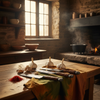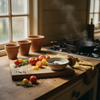Cooking Steak In Stainless Steel Pan: Complete Guide
Key Takeaways
- Cooking steak in a stainless steel pan achieves restaurant-quality searing at home.
- Stainless steel pans provide superior flavor compared to non-stick pans.
- These pans can withstand high heat necessary for perfect crust development.
- Using stainless steel avoids exposure to harmful chemicals found in some non-stick coatings.
Table of Contents
- Why Stainless Steel Reigns Supreme for Steak
- Essential Equipment: Beyond the Pan
- Steak Preparation: Setting Up Success
- Mastering Preheat and Oil Application
- Mastering the Sear: Step-by-Step Cooking Techniques in Stainless Steel
- Checking Doneness Like a Chef: Tools and Tactics
- The Crucial Rest: Juicy Steak, Every Time
- Plate Like a Pro: Serving, Slicing, and Flavor Finishes
- DI ORO Tools in Action: The Seamless Advantage for Steak and Beyond
- Troubleshooting & Pro Solutions: Crushing Common Stainless Steel Steak Problems
Cooking Steak in Stainless Steel Pan: Complete Guide
Want restaurant-quality steak without the restaurant? Cooking steak in stainless steel pan delivers superior searing, chemical-free safety, and flavor that non-stick simply can't match. Unlike coated pans that break down under high heat, stainless steel thrives at the temperatures needed for perfect crust development, all while keeping forever chemicals off your plate.
Professional kitchens choose stainless steel for steak because it conducts heat evenly, responds instantly to temperature changes, and creates the Maillard reaction that transforms a simple cut of beef into steakhouse perfection. With the right technique and tools, your Wednesday night dinner becomes a culinary victory.
For best results, equip yourself with 12-inch stainless steel kitchen tongs for precise flipping and a seamless spatula set that can handle high heat without damaging your pan or your food.
Why Stainless Steel Reigns Supreme for Steak
Stainless steel maximizes the Maillard reaction, the chemical process that creates steak's coveted golden-brown crust and complex flavors. This reaction requires sustained high heat (300°F+), which stainless steel maintains without releasing toxic fumes or degrading like coated pans.
The science is simple: stainless steel's even heat distribution prevents hot spots that char your steak before it's properly seared. Its responsive temperature control lets you adjust heat instantly, while the non-reactive surface preserves your steak's natural flavors without metallic interference.
Health-conscious home chefs choose stainless steel because it contains zero forever chemicals (PFAS), unlike non-stick surfaces that break down under high heat. When cooking steak in stainless steel pan, you're choosing flavor and safety over convenience, exactly what your family deserves.
Pro Insight: Stainless steel pans preheat 40% faster than cast iron and maintain temperature stability that's impossible with non-stick coatings.
Essential Equipment: Beyond the Pan

A quality stainless steel pan forms your foundation, but success requires the right supporting cast. Look for pans with thick, tri-ply construction that distributes heat evenly and prevents warping under high temperatures.
Your tool selection matters as much as technique. Professional-grade tongs provide precise control for flipping, while an instant-read thermometer eliminates guesswork. Most importantly, choose spatulas and utensils made from pro-grade silicone that won't melt, scratch your pan, or introduce chemicals into your food.
For a complete upgrade, consider the 2-piece kitchen tongs set (9-inch and 12-inch) for versatility with any cut of steak.
| Pan Type | Heat Performance | Responsiveness | Health Safety | Maintenance |
|---|---|---|---|---|
| Stainless Steel | Excellent searing | Instant adjustment | Zero chemicals | Dishwasher safe |
| Cast Iron | Good retention | Slow to adjust | Safe when seasoned | Hand wash only |
| Non-stick | Poor at high heat | Moderate | PFAS concerns | Delicate coating |
The DI ORO Seamless Spatula, winner of America's Test Kitchen's Best Silicone Spatula award, handles 600°F temperatures while remaining completely chemical-free. Its stainless steel core provides the rigidity needed for proper steak handling without bending under pressure.
Steak Preparation: Setting Up Success
Cut selection determines your success before you even heat the pan. Ribeye, New York strip, and sirloin excel in stainless steel thanks to their marbling and structure. Aim for steaks 1-1.5 inches thick, thinner cuts overcook before developing proper crust.
Dry brining transforms ordinary steak into restaurant quality. Salt your steak 40 minutes to overnight before cooking, allowing the salt to penetrate and break down proteins for maximum tenderness. If time is short, salt immediately before cooking rather than 10-20 minutes prior, which draws out moisture without reabsorption.
Room temperature matters. Remove steaks from refrigeration 20-30 minutes before cooking, then pat completely dry with paper towels. Surface moisture is the enemy of searing, every drop must evaporate before browning begins, wasting precious time and heat.
Choose high smoke-point oils like avocado (520°F) or refined canola (400°F). Avoid butter for initial searing, save it for basting during the final minutes when temperatures are more controlled.
For more tips on preparation and pan care, see our guide on how to cook with stainless steel.
Mastering Preheat and Oil Application
Proper preheating prevents sticking and ensures even searing. Heat your stainless steel pan over medium-high heat for 3-4 minutes until it passes the water test, a droplet should dance and evaporate within 2-3 seconds, not instantly sizzle or sit motionless.
Add 1-2 teaspoons of oil once the pan reaches temperature, swirling to coat evenly. The oil should shimmer but not smoke, if it's smoking, your pan is too hot. Reduce heat slightly and let the oil settle before adding your steak.
Mastering the Sear: Step-by-Step Cooking Techniques in Stainless Steel

Place your steak in the pan with confidence, literally. A gentle, deliberate placement prevents oil splatter and ensures even contact with the heated surface. Never drop or toss the steak; instead, lay it away from you to avoid any hot oil splash. The moment it hits the pan, you should hear a satisfying sizzle, not a violent screech that indicates the pan is too hot.
For the first sear, timing depends on your steak's thickness and desired doneness. A 1-inch ribeye needs 3-4 minutes for the first side when targeting medium-rare, while a 1.5-inch cut requires 4-5 minutes. Resist the urge to press down or move the steak, let the Maillard reaction work its magic. You'll know it's ready to flip when the edges start to brown and the steak releases easily from the pan surface.
The flip debate has been settled: frequent flipping actually creates a better crust. Professional chefs flip every 30-60 seconds, allowing each side to develop color while maintaining even internal cooking. This technique prevents overcooking the exterior before the center reaches temperature. Use tongs or a seamless long spatula for precise control without piercing the meat.
Don't forget the edges, especially on thick cuts with fat caps. Use your tongs to hold the steak upright, searing the edges for 30-60 seconds each. This renders the fat beautifully and creates a complete crust around the entire steak. For ribeyes and NY strips, this step transforms good into exceptional.
Butter basting elevates your steak from home-cooked to steakhouse quality. In the final 1-2 minutes of cooking, add 2 tablespoons of butter, fresh thyme sprigs, and smashed garlic cloves to the pan. Tilt the pan slightly and use a spoon, or your heat-resistant DI ORO spatula, to baste the aromatic butter over the steak repeatedly. This technique adds richness and helps achieve that final degree of doneness.
Choose your aromatics wisely. Hardy herbs like thyme and rosemary withstand the high heat, while delicate herbs like basil will burn. Garlic cloves should be smashed but left in their skins to prevent burning. The goal is fragrance and flavor infusion, not charred bits.
When steak sticks to the pan, patience is your friend. It will naturally release once the proteins have properly seared, usually after 2-3 minutes. If you're getting uneven browning, your pan temperature isn't consistent across the surface, or your steak thickness varies. For burnt fond, reduce heat immediately and deglaze with a splash of wine or broth.
Listen to your pan throughout the process. A steady sizzle indicates proper temperature; silence means too cool, while violent spattering means too hot. The sweet spot sounds like gentle, consistent bubbling, the sound of moisture evaporating and proteins browning at the perfect rate.
Checking Doneness Like a Chef: Tools and Tactics
An instant-read thermometer eliminates guesswork and delivers consistent results every time. Insert the probe into the thickest part of the steak, avoiding fat or bone. For accurate readings, angle the thermometer so the tip reaches the center of the meat. Remove your steak when it's 5°F below your target temperature, carryover cooking will bring it to perfection during the rest period.
| Doneness Level | Target Temperature | Remove at Temperature | Touch Test Feel |
|---|---|---|---|
| Rare | 120-125°F | 115-120°F | Soft, like the flesh between thumb and forefinger |
| Medium-Rare | 130-135°F | 125-130°F | Slightly firmer, like touching your cheek |
| Medium | 135-145°F | 130-140°F | Firm but yielding, like your chin |
| Medium-Well | 145-155°F | 140-150°F | Firm, like your forehead |
The touch test offers a thermometer-free method, though it requires practice. Press the center of your steak with tongs or your finger, the resistance should match the corresponding part of your hand when making an "OK" sign. While less precise than a thermometer, this technique helps you develop an intuitive feel for doneness levels.
Carryover cooking is real and significant. A thick steak can rise 5-10°F after leaving the pan, transforming your perfect medium-rare into medium. This phenomenon occurs because the exterior heat continues penetrating toward the center. Plan for it, and you'll nail your target doneness every time.
For a deep dive into pan-seared steak science and chef-tested techniques, check out this complete guide to pan-seared steaks.
The Crucial Rest: Juicy Steak, Every Time
Resting allows the muscle fibers to relax and redistribute juices throughout the meat. During cooking, heat drives moisture toward the center; resting gives those juices time to flow back through the entire steak. Skip this step, and your cutting board becomes a pool of lost flavor and moisture.
For more on why stainless steel is a favorite for steak, read our steak in stainless steel pan blog.
Plate Like a Pro: Serving, Slicing, and Flavor Finishes

The final moments between pan and plate can elevate your steak from good to restaurant-worthy. Start by slicing against the grain, identify the direction of the muscle fibers and cut perpendicular to them. This breaks down tough fibers, making even a well-done steak tender to chew.
Don't waste that beautiful fond clinging to your pan. While your steak rests, create a simple pan sauce by adding a tablespoon of butter to the warm pan and scraping up those caramelized bits. The result? A rich, beefy jus that amplifies every bite. For compound butter, mix softened butter with minced garlic, fresh herbs like thyme or rosemary, and a pinch of salt, it melts perfectly over hot steak.
Classic pairings never disappoint: roasted fingerling potatoes, sautéed mushrooms, or a crisp arugula salad with lemon vinaigrette. For something bolder, try chimichurri's bright herb punch or a cracked peppercorn crust pressed into the steak during its final minute of cooking. The beauty of cooking steak in stainless steel pan is how easily you can transition from searing to sauce-making in the same vessel.
If you want to expand your stainless steel skills, explore our article on cooking with stainless steel for more inspiration.
DI ORO Tools in Action: The Seamless Advantage for Steak and Beyond
When you're working with high-heat searing and delicate pan sauces, your tools matter as much as your technique. DI ORO's 5-piece seamless spatula set handles the 600°F heat of steak cooking without melting, warping, or releasing harmful chemicals into your food. That stainless steel core means no bending when you're scraping up fond or maneuvering a thick ribeye.
The seamless design eliminates bacteria-trapping crevices that plague traditional spatulas, crucial when handling raw and cooked meat. Our pro-grade silicone is LFGB certified and completely free of forever chemicals, BPA, and PFAS. While other spatulas might leave you questioning what's leaching into your perfectly seared steak, DI ORO tools deliver peace of mind with every flip.
| Feature | DI ORO Seamless Spatula | Standard Spatulas |
|---|---|---|
| Heat Resistance | 600°F tested | Often 400°F or less |
| Core Material | Stainless steel | Plastic or no core |
| Chemical Safety | Forever-chemical free | Often contains PFAS/BPA |
| Design | Seamless construction | Seamed edges trap bacteria |
After cooking, cleanup is effortless. These spatulas go straight into the dishwasher or clean with simple soap and water, no special treatments or worry about degrading non-stick coatings. When you're serious about both flavor and health, DI ORO tools let you cook confidently without compromise.
For a full range of utensils that support your steak and sauce game, browse our kitchen utensils collection.
Troubleshooting & Pro Solutions: Crushing Common Stainless Steel Steak Problems
Steak sticks to the pan: This almost always means insufficient preheating or a wet steak surface. Your pan needs that water droplet test, when a drop dances and evaporates in 2-3 seconds, you're ready. Pat your steak completely dry and let it develop a proper sear before attempting to move it. A well-seared steak releases naturally.
Too much smoke and burnt fond: You're likely using too much oil or your heat is too aggressive. Use just 1-2 teaspoons of high smoke-point oil, and remember that searing doesn't require maximum heat, medium-high usually suffices. If your fond turns black instead of golden-brown, lower the temperature immediately.
Edges burning before center cooks: This happens with steaks thicker than 1.5 inches. After searing both sides, transfer your pan to a 400°F oven to finish cooking. This gentle, even heat prevents edge burning while bringing the center to temperature. Use an instant-read thermometer to monitor progress.
Uneven browning patterns: Your pan likely has hot spots, or you're overcrowding. Cook one steak at a time in a properly sized pan, and resist the urge to press down, this creates uneven contact and steams the meat. Let the steak sit undisturbed for proper caramelization.
Quick Fix Reference
- Stuck steak: Wait 30 more seconds, then try lifting gently
- Excessive smoke: Lower heat, remove excess oil with paper towel
- Burnt pan: Deglaze with wine or broth while still warm
- Overcooked exterior: Next time, start with lower heat for thicker cuts
For more on the health and safety of cookware materials, see this scientific review of non-stick and stainless steel cookware.
Frequently Asked Questions
Why is a stainless steel pan better than a non-stick pan for cooking steak?
A stainless steel pan can withstand the high heat needed to develop the perfect crust on steak, which non-stick pans often can't handle without damage. It provides superior flavor by maximizing the Maillard reaction and offers even heat distribution without releasing harmful chemicals, preserving the steak’s natural taste.
What are the key steps to properly sear a steak in a stainless steel pan?
Preheat the pan thoroughly to ensure even heat, then add a high-smoke-point oil. Place the steak in the pan without moving it to develop a golden-brown crust, flip using precise tools, and finish cooking to your desired doneness before letting it rest for juicy results.
What essential tools and equipment should I use alongside a stainless steel pan for the best steak results?
Use a 12-inch stainless steel kitchen tong for precise flipping and a seamless spatula set made from pro-grade, heat-resistant silicone to handle high temperatures without damaging your pan or food. These tools help you cook confidently and protect your cookware.
How does stainless steel cookware contribute to healthier cooking compared to non-stick options?
Stainless steel cookware contains zero forever chemicals like PFAS, which can break down and release toxins under high heat in some non-stick pans. Choosing stainless steel means cooking safely at high temperatures without chemical exposure, keeping your food pure and your kitchen healthier.



